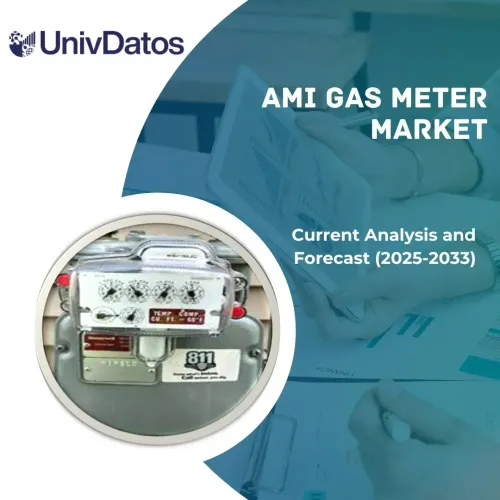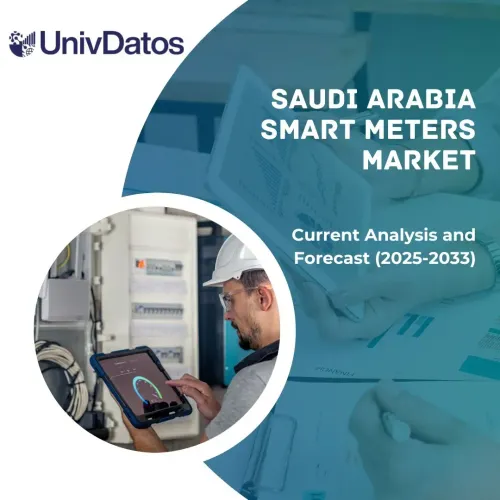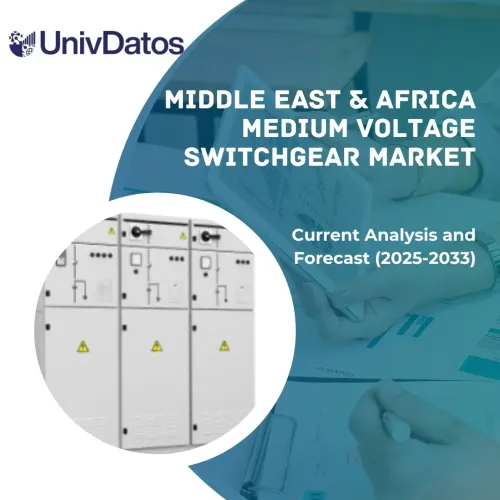- Home
- About Us
- Industry
- Services
- Reading
- Contact Us
US Solar Inverter Market: Current Analysis and Forecast (2023-2030)
Emphasis on Product Type (Central Inverter, String Inverter, and Micro Inverter); End-User (Residential, Commercial & Industrial, and Utility-scale); Phase (Single-Phase, and Three-Phase); System Type (On-Grid, and Off-Grid); Region.
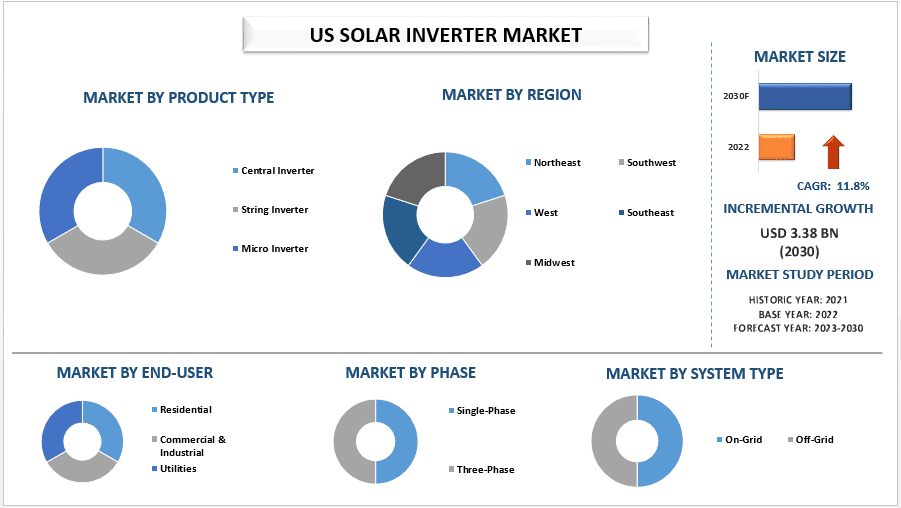
A solar inverter, also known as a photovoltaic (PV) inverter, is an important part of a solar energy system. Its main function is to convert the variable direct current (DC) output of photovoltaic panels to grid-frequency alternating current (AC), which can be fed into the commercial power grid or used in local off-grid power networks. This change allows the use of traditional AC-powered devices. Solar inverters are designed to absorb the fluctuating DC output of your panels and convert that power into 120 or 240-volt AC output. These replace the DC power collected by solar panels.
The US Solar Inverter Market, is expected to reach USD 3.38 Billion in 2030 by growing at a CAGR of 11.8%. The country acquired the second most share in the Global Solar Inverter market in the world and is one of the leading countries in the Solar Inverter industry in both revenues and research funding. It is mainly owing to supportive government policies, investment, and financial grants for the development of Solar Inverter facilities in the country that are fueling the market size. The USA has introduced new policies to fully monetize manufacturing tax credits in the United States which could bring all the country’s segments of solar PV manufacturing to cost parity with the lowest-cost manufacturers. In the United States, expansion already planned includes the manufacturing of roughly 9 GW of integrated crystalline silicon (c-Si) modules and 6 GW of thin-film panels.
The majority of states in the United States of America are heavily investing in renewable energy to meet their renewable energy targets and the solar energy market is one of the prominent sources of energy which has seen a massive boom in the last decade. For instance, In the USA, one of the leading nations for solar power, solar has experienced an average annual growth rate of 24% in the last decade alone. Thanks to strong federal policies like the Solar Investment Tax Credit, rapidly declining costs, and increasing demand across the private and public sectors for clean electricity, more than 155 gigawatts of solar capacity are installed nationwide, enough to power 27 million homes.
Some of the major players operating in the market include Siemens, Schneider Electric, Toshiba Mitsubishi-Electric Industrial Systems Corporation (TMEIC), Power Electronics S.L., SMA Solar Technology AG , Yaskawa Solectria Solar, Fimer Group, Chilicon Power, Huawei Technologies Co., Ltd. And Sungrow. Several M&As along with partnerships have been undertaken by these players to facilitate customers with hi-tech and innovative products/technologies.
Insights Presented in the Report
“Amongst Product Type, the Micro-Inverter segment to grow with a high CAGR during the forecast period”
Based on Product Type, the US Solar Inverter market is divided into central, string, and micro inverter segments. The Micro-Inverter segment is expected to showcase significant growth in the US Solar Inverter market during the forecast period due to rising sales of microinverters in the commercial and industrial segment. A micro inverter is an inverter that performs the same functions as a string inverter, but they are installed underneath the solar panels. The main driver for their growth is due to the functionality of improved solar panel monitoring in microinverters.
“Amongst End-User, the Utility-scale category held the dominant share of the market in 2022”
Based on End-User, the US Solar Inverter market is divided into Residential, Commercial & Industrial, and Utility-scale segments. The Utility-scale segment acquired a majority share in the US Solar Inverter market and is expected to showcase a substantial growth rate during the forecast period. Utility-scale PV remains the most competitive source of PV generation globally; however, building large-scale installations is becoming increasingly challenging in many regions of the world due to the lack of suitable sites. Moreover, Solar PV is the main choice for the private sector if they want to invest in renewable energy. Companies investing in distributed (including rooftop) solar PV installations on their commercial buildings and premises are responsible for around 30% of the total installed PV capacity, moreover, Companies are entering into corporate power purchase agreements with solar PV plant operators which would drive the market for US Solar Inverter during the forecast period.
“Amongst Phase, the Three-Phase segment to grow with a high CAGR during the forecast period”
Based on Phase, the US Solar Inverter market is divided into Single-Phase and Three-Phase segments. The Three-Phase segment is expected to showcase significant growth in the US Solar Inverter market during the forecast period due to increasing investments in utility-scale plants which usually deploy three-phase inverters. The main advantage that a three-phase inverter has over a single-phase is that it can transmit more power. A poly-phase system itself will produce power at constant rates within a load. The efficiency is also higher than in machinery that might be operated through a single phase.
“Amongst System Type, the On-Grid segment to grow with a high CAGR during the forecast period”
Based on System Type, the US Solar Inverter market is divided into On-Grid and Off-Grid segments. The On-Grid segment captured a significant share in the US Solar Inverter market during the forecast period on account of rising investments by private corporations in solar panels which are usually grid-connected. On-grid systems connect to the electric grid and supplement the power you receive from your utility company. In contrast, off-grid systems are entirely independent and rely on battery storage.
“Northeast held a dominant share of the market in 2022”
Northeast registered the highest market share in the US Solar Inverter market and is expected to witness an influential CAGR in the forecasted period. This is mainly owing to many Solar Photovoltaic (PV) Cell projects taking place in the area and states such as New York City, Philadelphia, and Boston having significant investments in the solar inverter industry. Moreover, favorable government policies, regulations, and investments in achieving renewable energy targets set by various states are driving the market. The Northeast is also one of the wealthiest parts of the United States in terms of per capita income and average household disposable income. The Massachusetts solar energy market is shaped by net metering and a renewable portfolio standard with a solar goal, along with an accompanying SREC market. The Solar Massachusetts Renewable Target (SMART) program was established in 2018 and has driven significant solar deployment in the state, acting as a template for other states to follow.
US Solar Inverter Market Report Coverage
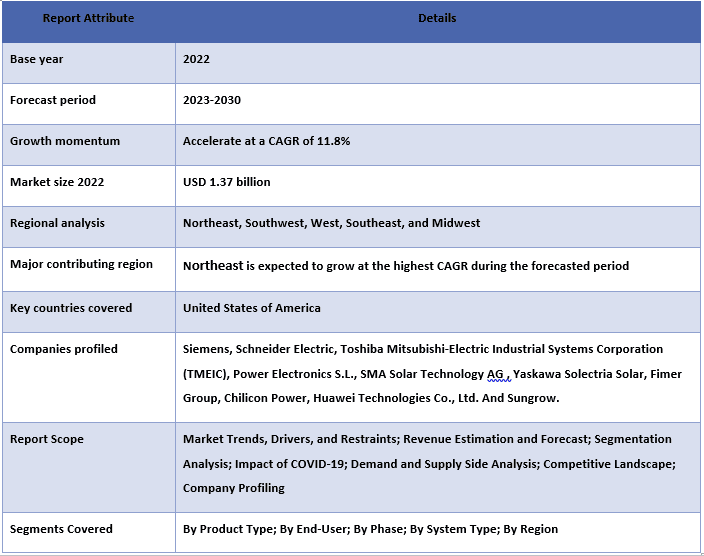
Reasons to buy this report:
- The study includes market sizing and forecasting analysis validated by authenticated key industry experts.
- The report presents a quick review of overall industry performance at one glance.
- The report covers an in-depth analysis of prominent industry peers with a primary focus on key business financials, product portfolios, expansion strategies, and recent developments.
- Detailed examination of drivers, restraints, key trends, and opportunities prevailing in the industry.
- The study comprehensively covers the market across different segments.
- Deep dive regional level analysis of the industry.
Customization Options:
The US Solar Inverter market can further be customized as per the requirement or any other market segment. Besides this, UMI understands that you may have your own business needs, hence feel free to connect with us to get a report that completely suits your requirements.
Table of Content
Research Methodology for the US Solar Inverter Market Analysis (2023-2030)
Analyzing the historical market, estimating the current market, and forecasting the future market of the US Solar Inverter market were the three major steps undertaken to create and analyze the adoption of the US Solar Inverter in major regions globally. Exhaustive secondary research was conducted to collect the historical market numbers and estimate the current market size. Secondly, to validate these insights, numerous findings and assumptions were taken into consideration. Moreover, exhaustive primary interviews were also conducted, with industry experts across the value chain of the US Solar Inverter market. Post assumption and validation of market numbers through primary interviews, we employed a top-down/bottom-up approach to forecasting the complete market size. Thereafter, market breakdown and data triangulation methods were adopted to estimate and analyze the market size of segments and sub-segments of the industry pertains to. Detailed methodology is explained below:
Analysis of Historical Market Size
Step 1: In-Depth Study of Secondary Sources:
A detailed secondary study was conducted to obtain the historical market size of the US Solar Inverter market through company internal sources such as annual reports & financial statements, performance presentations, press releases, etc., and external sources including journals, news & articles, government publications, competitor publications, sector reports, third-party database, and other credible publications.
Step 2: Market Segmentation:
After obtaining the historical market size of the US Solar Inverter market, we conducted a detailed secondary analysis to gather historical market insights and share for different segments & sub-segments for major regions. Major segments are included in the report as Product Type, End-User, Phase, and System Type. Further country-level analyses were conducted to evaluate the overall adoption of testing models in that region.
Step 3: Factor Analysis:
After acquiring the historical market size of different segments and sub-segments, we conducted a detailed factor analysis to estimate the current market size of the US Solar Inverter market. Further, we conducted factor analysis using dependent and independent variables such as Product Type, End-User, Phase, and System Type of the US Solar Inverter market. A thorough analysis was conducted for demand and supply-side scenarios considering top partnerships, mergers and acquisitions, business expansion, and product launches in the US Solar Inverter market sector across the globe.
Current Market Size Estimate & Forecast
Current Market Sizing: Based on actionable insights from the above 3 steps, we arrived at the current market size, key players in the US Solar Inverter market, and market shares of the segments. All the required percentage shares split, and market breakdowns were determined using the above-mentioned secondary approach and were verified through primary interviews.
Estimation & Forecasting: For market estimation and forecast, weights were assigned to different factors including drivers & trends, restraints, and opportunities available for the stakeholders. After analyzing these factors, relevant forecasting techniques i.e., the top-down/bottom-up approach were applied to arrive at the market forecast for 2030 for different segments and sub-segments across the market. The research methodology adopted to estimate the market size encompasses:
- The industry’s market size, in terms of revenue (USD) and the adoption rate of the US Solar Inverter market across the major market domestically
- All percentage shares, splits, and breakdowns of market segments and sub-segments
- Key players in the US Solar Inverter market in terms of products offered. Also, the growth strategies adopted by these players to compete in the fast-growing market
Market Size and Share Validation
Primary Research: In-depth interviews were conducted with the Key Opinion Leaders (KOLs) including Top Level Executives (CXO/VPs, Sales Head, Marketing Head, Operational Head, Regional Head, Country Head, etc.) across major regions. Primary research findings were then summarized, and statistical analysis was performed to prove the stated hypothesis. Inputs from primary research were consolidated with secondary findings, hence turning information into actionable insights.
Split of Primary Participants in Different Regions
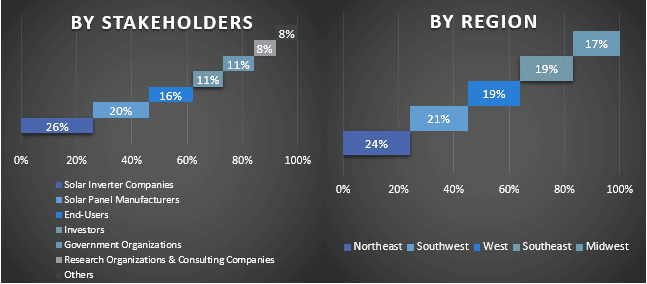
Market Engineering
The data triangulation technique was employed to complete the overall market estimation and to arrive at precise statistical numbers for each segment and sub-segment of the US Solar Inverter market. data was split into several segments & sub-segments post studying various parameters and trends in the areas of the Product Type, End-User, Phase, and System Type in the US Solar Inverter market.
The main objective of the US Solar Inverter market Study
The current & future market trends of the US Solar Inverter market were pinpointed in the study. Investors can gain strategic insights to base their discretion for investments on the qualitative and quantitative analysis performed in the study. Current and future market trends determined the overall attractiveness of the market at a regional level, providing a platform for the industrial participant to exploit the untapped market to benefit from a first-mover advantage. Other quantitative goals of the studies include:
- Analyze the current and forecast market size of the US Solar Inverter market in terms of value (USD). Also, analyze the current and forecast market size of different segments and sub-segments
- Segments in the study include areas of the Product Type, End-User, Phase, and System Type
- Define and analysis of the regulatory framework for the US Solar Inverter industry
- Analyze the value chain involved with the presence of various intermediaries, along with analyzing customer and competitor behaviors of the industry
- Analyze the current and forecast market size of the US Solar Inverter market for the major regions
- Major regions studied in the report include Northeast, Southwest, West, Southeast, and Midwest.
- Company profiles of the US Solar Inverter market and the growth strategies adopted by the market players to sustain in the fast-growing market
- Deep dive regional level analysis of the industry.
Related Reports
Customers who bought this item also bought

